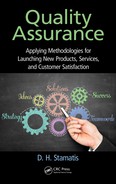125Quality Operating System (QOS)
• Revalidate measurable, quantiers, and quantifying tools on an
ongoing basis
• Issue meeting minute action items
• Keep an ongoing log of lessons learned and breakthrough
experiences
Example
To demonstrate the process and ow of QOS, let us show an example of
generating one. Our example is a baseball QOS.
Step 1. Customer expectations: What do the fans (customers) want
of their sport team?
Answer: Some possibilities are win the World Series, win
American or National league pennant, nish in top of divi-
sion,* or have a winning season. These and many more may be
identied through (a) market research, (b) focus groups, (c) sat-
isfaction surveys, (d) eld experience, (e) benchmarking, and
so on.
Step 2. Internal key process: Draft, trading of players, pitching/
hitting,* defense.
Answer: Key question here is what is important to the (a) pitcher,
(b) batter, (c) coach, and (d) owner. Therefore, if we choose the
key process as pitching and batting, the measurables have to
reect those characteristics. A measurable for a pitcher is pitch-
ing and for the batter is hitting. Now we are ready to proceed
with the identication of the quantiers.
Step 3. Measurables for key internal processes: In our example
here, we decided on pitching and hitting.
Answer: Depending on how we answered Step 2, our quanti-
ers will reect that selection. For this example, we have chosen
pitching and hitting as key processes. Therefore, the quantiers
are for pitching (ERA,* walks, and SO) and for hitting (team
average,* HR, power index, and RBI).
Step 4. Trend measurable: Trend with charts the key quantiers.
Answer: You may do a team ERA run chart or a composite com-
parison chart with last year’s performance; you may also do a
run chart on the team batting average or a composite compari-
son with last year’s performance. It is very interesting to note
here that baseball has more statistics than just about anything
that you can imagine not only for the team, but also for indi-
vidual players. The reason you do a trend here is to be able to
identify any special (sporadic) as opposed to common (chronic)
variation.
Step 5. Predict performance: Given the understanding of the key
measurables, we can now predict performance.
Answer: We may want to estimate correlation of ERA and
attendance. We may want to use scatter diagrams or correlation
analysis to nd the relationships that interest us.
126 Quality Assurance
Note: All items designated with an * have been identied as key
measurables of the process at hand. Of course, these may be
changed depending on what the objective is and who the cus-
tomer is.
Selected Bibliography
Ahmed, A. (2014). Solid base: Improve supplier assessments by incorporating process
factors into checklists. Quality Progress. June, 28–33.
Machado, H. (2014). Plan of attack: Managing the anatomy of your key projects is
fundamental to organizational success. Quality Progress. May, 32–37.
Ramu, G. (2014). Knowledge at work: Unleashing the power of knowledge workers.
Quality Progress. May, 52.
Ramu, G. (2014). Pay it forward: Anyone can invest in a culture of quality. Quality
Progress. May, 50.
..................Content has been hidden....................
You can't read the all page of ebook, please click here login for view all page.
